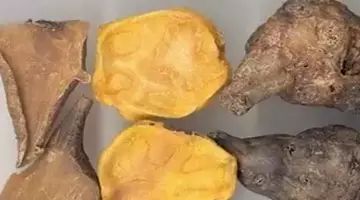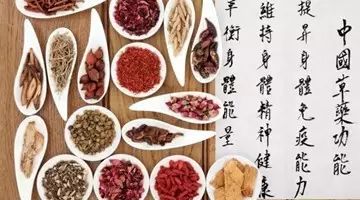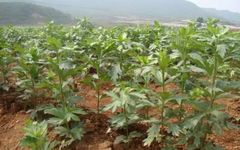
Introduction: Known as the “most important herb for supporting Yang,” Fuzi can either save a person from the brink of death or destroy them in an instant, capriciously influencing life and death. However, it is also a rare gift from heaven for supporting and elevating Yang. Due to its significant toxicity, many people keep their distance from it. Yet, those who are passionate about it never shy away from its toxic nature or ignore its existence. For instance, the old TCM practitioner mentioned in this article not only embraces it but has also conducted extensive research on it. Let’s take a closer look!
Fuzi is the processed root of the Aconitum carmichaelii Debx., a well-known and commonly used herb in TCM, widely applied in clinical practice. Modern pharmacological studies have confirmed that Fuzi contains effective components such as aconitine, mesaconitine, and non-alkaloids, which have cardiotonic and analgesic effects.
Traditional Chinese Medicine (TCM) believes that Fuzi has the functions of reviving Yang, warming kidney Yang, and dispelling cold to relieve pain. It is primarily used to treat conditions such as Yang deficiency with counterflow, excessive sweating leading to Yang loss, excess Yin obstructing Yang, deficiency cold with vomiting and diarrhea, cold pain in the heart and abdomen, wind-cold-damp obstruction, and all conditions characterized by deep cold and stubborn cold symptoms.
Fuzi is pungent, warm, and extremely hot in nature, with the ability to warm and tonify Yang Qi. However, its strong and fierce nature, along with its toxicity, means it is rarely used alone and must be combined with other herbs. As long as the diagnosis is accurate and the combination is appropriate, it often yields excellent therapeutic effects.
Fuzi has been used by physicians throughout history. For example, in the Han Dynasty, Zhang Zhongjing utilized Fuzi in 36 different formulas in his works, “Shang Han Lun” and “Jin Gui Yao Lue.” In the Ming Dynasty, Zhang Jingyue pointed out in his “Jingyue Quanshu: Supplement” that “those who are good at tonifying Yang must seek Yang within Yin, so that Yang can be supported by Yin and generate endless transformations.”

He also noted in his “Jingyue Quanshu: Heat Supplement” that “Fuzi is fierce and must be paired with very sweet substances, such as Ren Shen (Ginseng), Shu Di (Rehmannia), and Zhi Gan Cao (Honey-fried Licorice), which are sufficient to temper its fierceness and assist its courage, thus ensuring its benefits are maximized.” He further stated, “The nature of Fuzi is hot and fierce, it moves quickly and does not stay… It is precisely desired to use its heat to revive the original Yang, to tonify the spleen and kidney, and to perform the functions of Ren Shen, Qi, Shu Di, etc.”
Yu Tuan said: “Fuzi possesses a robust quality, with the ability to cut through barriers and seize victory, capable of guiding tonifying Qi herbs through the twelve meridians to restore lost original Yang. It can guide blood tonifying herbs into the blood to nourish the improper true Yin. It can also lead dispersing herbs to open the pores to expel wind-cold from the surface. It can guide warming herbs to the lower jiao to dispel internal cold-dampness.”
Wu Shou stated: “Fuzi is a crucial herb for Yin conditions. In cases of cold damage transforming into three Yin conditions and middle cold mixed with Yin, even if the body is very hot but the pulse is deep, it must be used. In cases of cold limbs and abdominal pain, with a deep and thin pulse, especially if the lips are blue and the abdomen is contracted, it is urgent to use it, as it has the power to expel Yin and revive Yang, with the ability to bring the dead back to life.”
Old Zou often uses Fuzi in clinical practice without ever encountering poisoning incidents. However, he usually combines Fuzi with Gan Jiang (Dried Ginger) and Zhi Gan Cao (Honey-fried Licorice) to assist Fuzi in warming Yang and to resolve its toxicity, ensuring safety.
1. Clinical Applications
1. Shock due to Yang Qi exhaustion, heart failure leading to Yin water, etc.
Fuzi combined with Ren Shen (Ginseng), Gan Jiang (Dried Ginger), Zhi Gan Cao (Honey-fried Licorice), Bai Zhu (White Atractylodes), and Fu Ling (Poria) has the effect of warming Yang and rescuing from counterflow, strengthening the heart, and stabilizing collapse, often used in cases of shock due to Yang Qi exhaustion and heart failure leading to Yin water.
2. Cold-deficiency bronchial asthma
Fuzi combined with Ma Huang (Ephedra), Gui Zhi (Cinnamon Twig), Xi Xin (Asarum), Gan Jiang (Dried Ginger), and Wu Wei Zi (Schisandra) has the effect of dispersing cold and calming wheezing, often used in cases of cold-deficiency bronchial asthma.
3. Cold-deficiency Yin abscess
Fuzi combined with Rou Gui (Cinnamon), Shu Di (Rehmannia), and Lu Jiao Jiao (Deer Antler Glue) has the effect of warming and tonifying kidney Yang to disperse cold and resolve stagnation, often used for “Yin abscess” (bone tuberculosis) classified as cold-deficiency syndrome.
4. Rheumatoid arthritis and cold-type rheumatism
Fuzi combined with Bai Hua She (White Flower Snake), Wu Gong (Centipede), Cang Zhu (Atractylodes), Du Huo (Angelica Pubescens), and Dang Gui (Angelica Sinensis) has the effect of dispelling wind-dampness, dispersing cold, and relieving pain, often used in cases of cold-type rheumatoid arthritis and rheumatism.

5. Cold-deficiency chronic cholecystitis
Fuzi combined with Da Huang (Rhubarb), Xi Xin (Asarum), Mian Yin Chen (Capillaris), and Yu Jin (Curcuma) has the effect of dispersing cold, relieving pain, and warming the gallbladder, often used in cases of chronic cholecystitis (biliary colic) classified as cold-deficiency type.
6. Dizziness and bradycardia due to Yang Qi deficiency
Fuzi combined with Dang Shen (Codonopsis), Huang Qi (Astragalus), Gui Zhi (Cinnamon Twig), Bai Shao (White Peony), and Zhi Gan Cao (Honey-fried Licorice) has the effect of warming and tonifying Yang Qi, often used in cases of dizziness and bradycardia due to Yang Qi deficiency.
7. Cold-deficiency diarrhea and chest obstruction
Fuzi combined with Gan Jiang (Dried Ginger), Ren Shen (Ginseng), Bai Zhu (White Atractylodes), and Zhi Gan Cao (Honey-fried Licorice) has the effect of warming and tonifying spleen Yang to stop diarrhea and warming and tonifying heart Yang to treat chest obstruction, often used in cases of cold-deficiency diarrhea and chest obstruction (angina).
2. Insights
Fuzi is a fierce general for warming Yang. In clinical practice, as long as there are signs of Yang deficiency: pale complexion, fear of cold, cold limbs, clear and long urination, loose stools, no thirst or preference for hot drinks, cold pain in the abdomen, lower limb edema, chronic wheezing, dizziness, palpitations, joint pain, with a pale and moist tongue, and a deep, thin, and slow pulse, all of which indicate a pattern of cold deficiency, Fuzi can be applied. If there are also signs of heat, it can be combined with heat-clearing herbs.
Old Zou often uses a dosage of Fuzi ranging from 10 to 15 grams, usually combined with Gan Jiang or Gan Cao to resolve its toxicity, and it does not need to be pre-boiled. When using large doses (30 to 60 grams) of Fuzi, it must be boiled for 2 to 3 hours first, as Fuzi contains aconitine, and prolonged heating can destroy some aconitine, thereby reducing its toxicity.
⊙ Copyright Statement: The article is sourced from the internet. If there is any infringement, please contact us for deletion.
⊙ Note: The content of this article is for the popularization of TCM knowledge and is not intended as a prescription. Please consult a doctor before use.
Fuzi 3. Learn about one TCM herb every day - Fuzi 4. The truth about inferior FuziThis product is a processed product of the root of the Aconitum carmichaelii Debx., a plant of the Ranunculaceae family. It is harvested from late June to early August, with the mother root, fibrous roots, and soil removed, commonly referred to as "mud Fuzi," processed into the following specifications. (1) Select large, uniform mud Fuzi, wash it, soak it in a solution of gall water overnight, then add salt, continue soaking, taking it out daily to dry, gradually extending the drying time until the surface of Fuzi appears with a large number of crystallized salt particles (salt frost), and the texture becomes hard, commonly referred to as "salt Fuzi." (2) Take mud Fuzi, wash it according to size, soak it in a solution of gall water for several days, boil it until thoroughly cooked, remove it, rinse with water, cut it into slices about 0.5 cm thick, then soak in water, dye the slices with a coloring solution to a deep tea color, steam until an oily surface and gloss appear, then dry until half dry or continue drying, commonly referred to as "black slices." (3) Select uniform-sized mud Fuzi, wash it, soak it in a solution of gall water for several days, boil it with the soaking liquid until thoroughly cooked, remove the skin, cut it into slices about 0.3 cm thick, soak in water, steam until cooked through, and dry, commonly referred to as "white slices." 【Characteristics】 Salt Fuzi is conical, 4-7 cm long, 3-5 cm in diameter. The surface is gray-black, covered with salt frost, with a depressed bud scar at the top, surrounded by tuberous protrusions or root scars. It is heavy, with a gray-brown cross-section, visible small voids filled with salt frost and polygonal formation layer rings, with irregularly arranged vascular bundles on the inner side of the rings. It has a faint odor, a salty and numbing taste, and a tingling sensation on the tongue. Black slices are longitudinally cut, wider at the top and narrower at the bottom, 1.7-5 cm long, 0.9-3 cm wide, and 0.2-0.5 cm thick. The outer skin is black-brown, the cut surface is dark yellow, oily and glossy, semi-transparent, with longitudinal vascular bundles. It is hard and brittle, with a waxy fracture surface. It has a faint odor and a bland taste. White slices have no outer skin, are yellow-white, semi-transparent, and about 0.3 cm thick. 【Identification】 Take 2 g of this product powder, add 3 ml of ammonia test solution to moisten, add 25 ml of ether, treat with ultrasound for 30 minutes, filter, evaporate the filtrate, and dissolve the residue in 0.5 ml of dichloromethane to prepare the test solution. Take benzoyl new aconitine reference, benzoyl aconitine reference, and benzoyl mesaconitine reference, and prepare a mixed solution containing 1 mg in each 1 ml with isopropanol-dichloromethane (1:1) as the reference solution (monoester alkaloids). Then take new aconitine reference, mesaconitine reference, and aconitine reference, and prepare a mixed solution containing 1 mg in each 1 ml with isopropanol-dichloromethane (1:1) as the reference solution (diester alkaloids). Perform thin-layer chromatography (General Rule 0502) test, applying 5-10 μl of the test solution and reference solution on the same silica gel G thin-layer plate, using n-hexane-ethyl acetate-methanol (6.4:3.6:1) as the developing agent, place in an ammonia vapor-saturated developing chamber for 20 minutes, develop, remove, dry, and spray with dilute potassium iodide solution. In the test chromatogram, salt Fuzi shows the same color spots as the new aconitine reference, mesaconitine reference, and aconitine reference at corresponding positions; black slices or white slices show the same color spots as the benzoyl new aconitine reference, benzoyl aconitine reference, and benzoyl mesaconitine reference at corresponding positions. 【Inspection】 Moisture must not exceed 15.0% (General Rule 0832, second method). Diester alkaloids are tested under the content determination section, with the chromatographic conditions and preparation methods for the test solution. Preparation of reference solution: Take appropriate amounts of new aconitine reference, mesaconitine reference, and aconitine reference, accurately weigh, and prepare a mixed solution containing 5 μg in each 1 ml with isopropanol-dichloromethane (1:1). Determination method: Accurately absorb 10 μl of the above reference solution and test solution, inject into the liquid chromatography instrument, and determine. This product contains diester alkaloids, with a total amount of new aconitine (C33H45NO11), mesaconitine (C33H45NO10), and aconitine (C34H47NO11) not exceeding 0.020%. 【Content Determination】 Determined by high-performance liquid chromatography (General Rule 0512). Chromatographic conditions and system suitability test: Using octadecylsilyl-bonded silica gel as the filler; using acetonitrile-tetrahydrofuran (25:15) as mobile phase A, and 0.1 mol/L ammonium acetate solution (add 0.5 ml of glacial acetic acid to every 1000 ml) as mobile phase B, perform gradient elution according to the specifications in the table, with a detection wavelength of 235 nm. Theoretical plate number calculated based on the peak of benzoyl new aconitine should not be less than 3000. Preparation of reference solution: Take appropriate amounts of benzoyl new aconitine reference, benzoyl aconitine reference, and benzoyl mesaconitine reference, accurately weigh, and prepare a mixed solution containing 10 μg in each 1 ml with isopropanol-dichloromethane (1:1). Preparation of test solution: Take about 2 g of this product powder (passed through a No. 3 sieve), accurately weigh, place in a stoppered conical flask, add 3 ml of ammonia test solution, accurately add 50 ml of isopropanol-ethyl acetate (1:1) mixed solution, weigh, treat with ultrasound (power 300W, frequency 40kHz, water temperature below 25°C) for 30 minutes, cool, reweigh, and use isopropanol-ethyl acetate (1:1) mixed solution to make up for the lost weight, shake well, and filter. Accurately take 25 ml of the filtrate, recover the solvent under reduced pressure below 40°C until dry, and accurately add 3 ml of isopropanol-dichloromethane (1:1) mixed solution to dissolve, filter, and take the filtrate. Determination method: Accurately absorb 10 μl of the reference solution and test solution, inject into the liquid chromatography instrument, and determine. This product, calculated on a dry basis, contains benzoyl new aconitine (C31H43NO10), benzoyl aconitine (C32H45NO10), and benzoyl mesaconitine (C31H43NO9) with a total amount not less than 0.010%. 【Herbal Pieces】 【Processing】 Fuzi slices (black slices, white slices) are used directly in medicine. 【Inspection】 Total ash must not exceed 6.0% (General Rule 2302). Acid-insoluble ash must not exceed 1.0% (General Rule 2302). 【Characteristics】【Identification】【Inspection】 (Moisture, diester alkaloids) 【Content Determination】 Same as medicinal materials. Light Fuzi slices: Take salt Fuzi, soak in clean water, changing water 2-3 times daily, until the salt is completely removed, boil with Gan Cao (Licorice) and black beans until thoroughly cooked, until there is no numbing sensation when tasted after cutting, remove, discard Gan Cao and black beans, cut into thin slices, and dry. For every 100 kg of salt Fuzi, use 5 kg of Gan Cao and 10 kg of black beans. 【Characteristics】 This product is longitudinally cut slices, wider at the top and narrower at the bottom, 1.7-5 cm long, 0.9-3 cm wide, and 0.2-0.5 cm thick. The outer skin is brown. The cut surface is brown, semi-transparent, with longitudinal vascular bundles. It is hard, with a waxy fracture surface. It has a faint odor, a bland taste, and no numbing sensation when tasted. 【Inspection】 Diester alkaloids same as medicinal materials, containing diester alkaloids with new aconitine (C33H45NO11), mesaconitine (C33H45NO10), and aconitine (C34H47NO11) with a total amount not exceeding 0.010%. Total ash must not exceed 7.0% (General Rule 2302). Acid-insoluble ash must not exceed 1.0% (General Rule 2302). 【Identification】【Inspection】 (Moisture) 【Content Determination】 Same as medicinal materials. Processed Fuzi slices: Take Fuzi slices, fry according to the frying method (General Rule 0213) until they puff up and slightly change color. 【Characteristics】 This product resembles black slices or white slices, with a surface that is puffed and yellow-brown, and a loose and brittle texture. It has a faint odor and a bland taste. 【Identification】【Inspection】 Same as Fuzi slices. 【Nature and Channels Entered】 Pungent, sweet, extremely hot; toxic. Enters the heart, kidney, and spleen channels. 【Functions and Indications】 Revives Yang, rescues from counterflow, supplements fire to assist Yang, dispels cold, and relieves pain. Used for Yang loss and collapse, cold limbs with weak pulse, insufficient heart Yang, chest obstruction and heart pain, cold-deficiency vomiting and diarrhea, cold pain in the abdomen, kidney Yang deficiency, impotence, cold water retention, Yang deficiency with external pathogens, and cold-damp obstruction pain. 【Dosage and Administration】 3-15 g, first boiled, long boiled. 【Precautions】 Use with caution in pregnant women; should not be used with Ban Xia (Pinellia), Gua Lou (Trichosanthes), Gua Lou Zi (Trichosanthes Seed), Gua Lou Pi (Trichosanthes Peel), Tian Hua Fen (Trichosanthes Root), Chuan Bei Mu (Fritillaria), Zhe Bei Mu (Fritillaria), Ping Bei Mu (Fritillaria), Yi Bei Mu (Fritillaria), Hu Bei Bei Mu (Fritillaria), Bai Shao (White Peony), Bai Ji (Bletilla), and others. 【Storage】 Salt Fuzi: Sealed, stored in a cool, dry place; black slices and white slices: stored in a dry place, protected from moisture. Note: Salt Fuzi is only for [characteristics] testing.
 Click the title below to view detailed content!
Click the title below to view detailed content!
A formula to nourish the liver and replenish… just needs one herb to brew tea: Shan Zhu Yu (Cornus)
Understanding TCM herbs: Lu Jiao (Deer Antler), Lu Rong (Deer Velvet), Lu Jiao Jiao (Deer Antler Glue), Lu Jiao Shuang (Deer Antler Powder)
Learn about one TCM herb every day: Lu Rong (Deer Velvet)
TCM: Chuan Xiong (Ligusticum)
Understanding TCM herbs: Xia Ku Cao (Selfheal)
Understanding TCM herbs: Hong Hua (Safflower), Zang Hong Hua (Safflower)
Understanding TCM herbs: Ban Xia (Pinellia), Fa Ban Xia (Fried Pinellia), Jiang Ban Xia (Ginger Pinellia), Qing Ban Xia (Clear Pinellia)
Understanding TCM herbs: Fu Ling (Poria) (with Fu Shen)
Understanding TCM herbs: Gan Cao (Licorice)
Understanding TCM herbs: Xiao Mi (Millet), a TCM herb
Understanding TCM herbs: Gou Qi Zi (Goji Berries)
How to eat Gou Qi Zi, there is much knowledge
Understanding TCM herbs: Sha Yuan Zi (Astragalus), a good herb for nourishing the liver and kidneys
Understanding TCM herbs: Ma You (Sesame Oil)
Understanding TCM herbs: Qian Dan (Lead Red), its effects and functions
Understanding one TCM herb: Huang Bai (Phellodendron)
Understanding one TCM herb: Huang Qin (Scutellaria)
Understanding one TCM herb: Huang Lian (Coptis)
Learn about one TCM herb every day: Lu Rong (Deer Velvet)
Learn about one TCM herb every day: Wei Ling Xian (Clematis)
Learn about one TCM herb every day: Dang Yao (Angelica)
Learn about one TCM herb every day: Bing Pian (Borneol)
Learn about one TCM herb every day: Bu Guo Zhi (Psoralea)
Learn about one TCM herb every day: Da Zao (Jujube)
TCM Science || A single herb to treat high blood lipids, non-toxic and effective
A secret formula using ants to treat hundreds of diseases
Learn about one TCM herb every day: Wu Wei Zi (Schisandra)
Understanding one TCM herb: Zhu Ye Shen (Bamboo Leaf Ginseng), a folk herb that addresses ten common ailments like rheumatism and bone pain!
For more medical and health knowledge, follow this public account, and let’s work together for future health.
For more medical and health knowledge, follow this public account, and let’s work together for future health.
You have read  ·
·
 seconds, feeling good, you can share or follow the QR code below
seconds, feeling good, you can share or follow the QR code below


This subscription account disclaims responsibility
This subscription account disclaims responsibility
Copyright Statement: This platform is dedicated to sharing quality articles and in-depth reading. Some articles may not have been able to contact the original author when pushed. Copyright belongs to the original author; if there is any infringement, please contact the original author for deletion!
Copyright Statement: This platform is dedicated to sharing quality articles and in-depth reading. Some articles may not have been able to contact the original author when pushed. Copyright belongs to the original author; if there is any infringement, please contact the original author for deletion!

